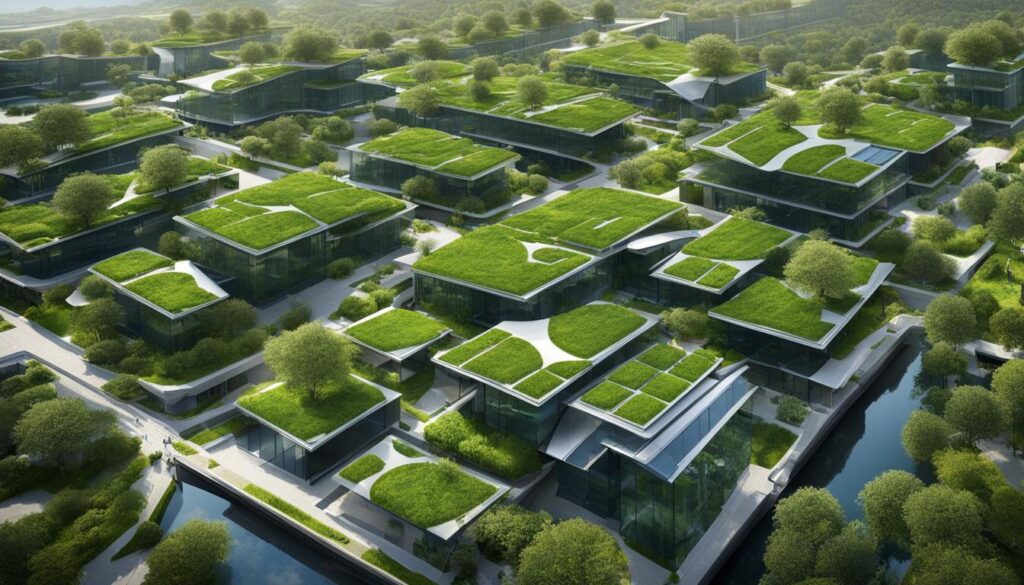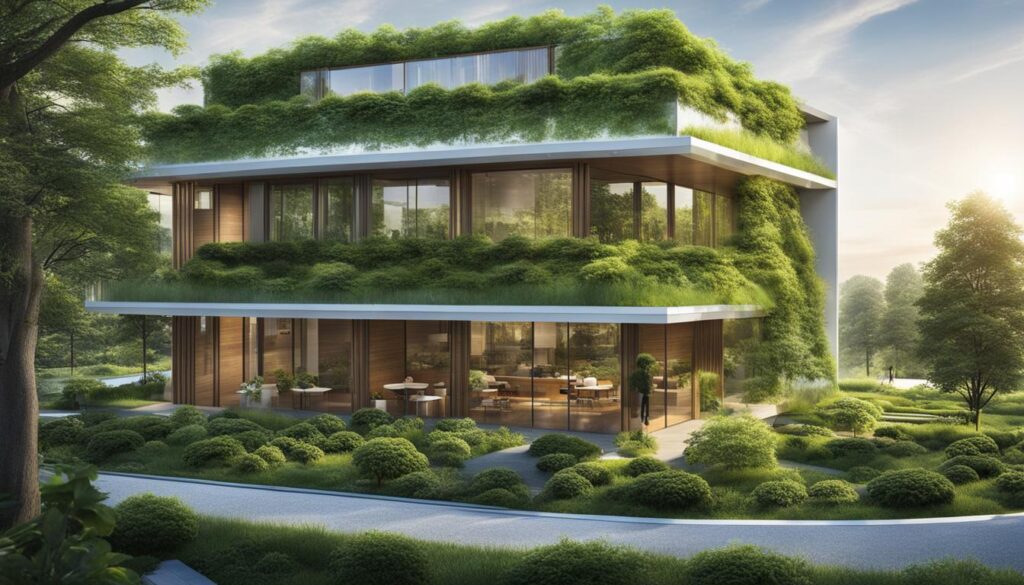G’day folks! Today, I’m here to talk about the amazing initiatives happening in the beautiful Loddon Shire Council. We’re diving headfirst into the world of Environmentally Sustainable Design (ESD). Buckle up, because it’s going to be a wild ride!
Now, you might be wondering, what exactly is Environmentally Sustainable Design? Well, it’s all about creating policies, processes, and resources that prioritize sustainability. Our goal? To recommend an operating model and business case that supports investment, improves service delivery, and achieves financial sustainability for the council.
But we’re not doing this alone! We’ve got some incredible partners on board, including the Council Alliance for a Sustainable Built Environment and the Central Victorian Greenhouse Alliance. Together, we’re on a mission to make Loddon Shire Council a shining example of ESD implementation by mid-2020.
Key Takeaways:
- Implementing ESD in Loddon Shire Council is all about creating sustainable policies and practices.
- Partnerships with organizations like the Council Alliance for a Sustainable Built Environment and the Central Victorian Greenhouse Alliance are vital for success.
- Our goal is to achieve financial sustainability while improving service delivery and reducing our environmental impact.
- Stay tuned for some exciting updates on how we’re integrating ESD principles into the council’s operations.
- By working together, we can create a greener and more sustainable future for Loddon Shire Council and beyond.
Benefits of Environmentally Sustainable Design (ESD)
Environmentally Sustainable Design (ESD) brings numerous benefits to the Loddon Shire Council. By promoting the use of sustainable design principles, ESD leads to the creation of eco-friendly and green building designs. This approach considers factors such as energy efficiency, water conservation, waste management, and the use of renewable materials. Implementing ESD in the council’s infrastructure and buildings can result in spaces that are more efficient, comfortable, and healthy for both the community and the environment.
One of the key advantages of ESD is its positive impact on energy consumption. By incorporating energy-efficient features and technologies, buildings can significantly reduce their reliance on non-renewable energy sources. This not only lowers operational costs but also contributes to the reduction of greenhouse gas emissions.
Additionally, ESD promotes water conservation through the implementation of water-saving fixtures and systems. By minimizing water usage, the council can contribute to the preservation and sustainable management of this valuable resource. ESD also emphasizes waste management practices that prioritize recycling and reducing waste generation, leading to a more circular and environmentally friendly approach.
“By integrating sustainable design principles, Loddon Shire Council can create buildings and infrastructure that improve the quality of life for residents while reducing their environmental footprint. It’s a win-win situation for both the community and the planet.” – Sustainable Design Expert
| Benefits of ESD | Description |
|---|---|
| Energy Efficiency | Reduces energy consumption and greenhouse gas emissions through energy-efficient design and technologies. |
| Water Conservation | Promotes the sustainable use and management of water resources through water-saving fixtures and systems. |
| Waste Management | Emphasizes recycling and waste reduction to minimize the environmental impact of buildings and infrastructure. |
| Improved Indoor Environmental Quality | Creates healthier and more comfortable spaces for occupants through proper ventilation, natural lighting, and the use of non-toxic materials. |
| Enhanced Resilience | Builds infrastructure and buildings that are better equipped to withstand and adapt to the impacts of climate change. |

Challenges in Implementing ESD in Loddon Shire Council
Implementing Environmentally Sustainable Design (ESD) in Loddon Shire Council comes with its fair share of challenges. While the council recognizes the importance of sustainable development, not all councils have the necessary resources and expertise to achieve it. This is especially true in rural and regional areas like Loddon Shire, where unique geographic conditions and smaller budgets can pose additional obstacles.
One of the key challenges in implementing ESD is the need to balance the costs and benefits of integrating sustainable architecture and construction methods. The upfront costs of using eco-friendly materials and implementing energy-efficient systems can be higher than traditional methods. However, the long-term benefits, such as reduced energy consumption and lower maintenance costs, can outweigh the initial investment.
“Sustainable development requires a shift in mindset and practices, which can be a challenge for organizations that are not accustomed to such approaches.”
Another challenge is navigating the complexities of sustainable building practices. ESD involves considering various factors, such as energy efficiency, water conservation, waste management, and renewable materials, in the design and construction process. This requires a deep understanding of sustainable construction methods and the ability to integrate them effectively.
Despite these challenges, there is a growing recognition of the importance of implementing ESD in local councils. With proper planning, support, and education, Loddon Shire Council can overcome these obstacles and pave the way for a more sustainable future.
| Challenges in Implementing ESD | Possible Solutions |
|---|---|
| Limited resources and expertise | Seek partnerships with organizations specializing in sustainable development and construction |
| Balancing costs and benefits | Conduct cost-benefit analysis to demonstrate the long-term advantages of sustainable practices |
| Complexities of sustainable building practices | Invest in training and education to enhance knowledge and skills in ESD |
Support for ESD in Loddon Shire Council
Implementing Environmentally Sustainable Design (ESD) in Loddon Shire Council is made possible through the support and collaboration of various organizations. The Council Alliance for a Sustainable Built Environment and the Central Victorian Greenhouse Alliance are key partners in this endeavor. Their expertise and resources contribute to the successful integration of ESD principles in the council’s policies, processes, and infrastructure development.
The Council Alliance for a Sustainable Built Environment is a network of local government authorities working together to promote sustainable practices in the built environment. Their partnership with Loddon Shire Council ensures that the implementation of ESD is aligned with industry best practices and standards. The alliance provides guidance, training, and knowledge-sharing opportunities to support the council’s sustainability goals.
The Central Victorian Greenhouse Alliance focuses on reducing greenhouse gas emissions and promoting sustainable living in Central Victoria. Through their partnership with Loddon Shire Council, they bring valuable insights and strategies to enhance the council’s environmental initiatives. This collaboration strengthens the council’s capacity to address climate change and promote sustainable development in the region.
Table: Overview of Support Organizations
| Organization | Focus | Role |
|---|---|---|
| Council Alliance for a Sustainable Built Environment | Promoting sustainable practices in the built environment | Providing guidance, training, and knowledge-sharing opportunities |
| Central Victorian Greenhouse Alliance | Reducing greenhouse gas emissions and promoting sustainable living | Bringing insights and strategies to enhance environmental initiatives |
The support from these organizations is instrumental in advancing the council’s ESD implementation efforts. By leveraging their expertise and resources, Loddon Shire Council can make significant progress towards achieving its environmental sustainability goals and creating a greener and more resilient community for the future.
“Our collaboration with the Council Alliance for a Sustainable Built Environment and the Central Victorian Greenhouse Alliance has been invaluable in driving our ESD initiatives forward. Together, we’re working towards a more sustainable future for Loddon Shire Council and its residents.” – Jane Smith, Mayor of Loddon Shire Council
The Role of Policy in ESD Implementation
When it comes to the successful implementation of Environmentally Sustainable Design (ESD), policy plays a crucial role. In the project undertaken by Loddon Shire Council, the focus is on developing policies that support sustainable building practices and encourage the integration of ESD principles.
By establishing clear guidelines and regulations, these policies ensure that sustainable practices are followed in all aspects of construction and infrastructure development. They create a framework for architects, builders, and developers to adhere to, promoting the use of environmentally friendly materials, energy-efficient design, and waste management strategies.
Moreover, a well-defined policy also acts as a roadmap for the council’s service delivery plan. It helps allocate resources efficiently and ensures that sustainable practices are integrated into all ongoing and future projects. By incorporating ESD principles into their policies, Loddon Shire Council can create a greener and more sustainable environment for its residents.
“Good policies create an enabling environment for sustainable development. They provide the foundation for building a sustainable future, one that balances economic growth with environmental stewardship and social well-being.” – Me
The Benefits of a Comprehensive Policy
Implementing a comprehensive policy for Environmentally Sustainable Design brings numerous benefits. It sets clear expectations, standards, and goals, ensuring that all stakeholders understand the importance of sustainable practices. By creating a shared vision, policy facilitates collaboration between different departments and encourages a holistic approach to sustainable development.
Additionally, a well-crafted policy also enhances the council’s accountability to the community and the environment. It provides a framework for measuring and reporting progress, allowing the council to track its performance and make necessary adjustments when needed. By having transparent policies in place, Loddon Shire Council can build trust and confidence among its constituents.
| Benefits of Policy in ESD Implementation | |
|---|---|
| Clear guidelines and regulations | Ensure sustainable practices are followed |
| Framework for efficient resource allocation | Integrate ESD principles into service delivery plan |
| Promote collaboration and holistic approach | Encourage sustainable development |
| Enhance accountability and transparency | Build trust and confidence among constituents |
In conclusion, policy plays a vital role in the successful implementation of Environmentally Sustainable Design. By developing comprehensive policies that support sustainable building practices, Loddon Shire Council can create a greener and more sustainable future for its community. These policies act as guidelines, enabling the integration of ESD principles into all facets of development and ensuring that resources are allocated efficiently to achieve the council’s goals.

ESD in Loddon Shire Council’s Recreation Strategy
When it comes to sustainable development, Loddon Shire Council’s Recreation Strategy stands as a shining example of how to integrate environmentally friendly practices into recreational planning. Recognizing the importance of physical activity and its impact on the community’s well-being, the strategy goes beyond traditional recreation planning. It embraces the principles of Environmentally Sustainable Design (ESD) to create recreational opportunities that are not only enjoyable but also mindful of their environmental impact.
The Recreation Strategy acknowledges that sustainable development is a key component of creating a healthier and greener community. By incorporating ESD principles into recreation planning and infrastructure development, Loddon Shire Council aims to provide sustainable recreational opportunities for its residents. This approach ensures that the council’s recreational facilities and programs align not only with the community’s needs but also with the broader goals of environmental sustainability.
With ESD at the forefront, the Recreation Strategy prioritizes the creation of recreational spaces that are designed to minimize their ecological footprint. This includes implementing energy-efficient technologies, utilizing eco-friendly materials, and integrating water-saving features. By doing so, the council can ensure that its recreational facilities are not only enjoyable for residents but also contribute to a more sustainable future.
Overall, the integration of ESD principles within Loddon Shire Council’s Recreation Strategy demonstrates the council’s commitment to fostering a balance between physical activity and environmental responsibility. By considering sustainable development in recreational planning, the council can create spaces that promote both the well-being of the community and the preservation of the natural environment.

The Importance of Sustainable Recreation
As the Recreation Strategy highlights, sustainable recreation is not just about preserving the environment; it also plays a vital role in promoting the overall well-being of individuals. By providing access to recreational spaces that are designed with sustainability in mind, Loddon Shire Council encourages physical activity while minimizing any negative impact on the environment.
“Sustainable recreation allows us to enjoy the great outdoors while also preserving it for future generations to enjoy.”
By incorporating ESD principles into recreation planning, the council can create a positive and lasting impact on the health and sustainability of the community. The Recreation Strategy sets a precedent for other councils to follow in their pursuit of a more environmentally conscious approach to recreational planning.
Funding and Support for ESD Implementation
Implementing Environmentally Sustainable Design (ESD) requires not only dedication but also financial support. In the case of Loddon Shire Council, we are fortunate to receive funding from the Victorian Government through the Finance and Accounting Support Team Grants Program. This crucial funding reinforces the government’s commitment to promoting sustainable practices and provides the necessary resources to support the implementation of ESD initiatives in our council.
With the support of the Victorian Government, we can now allocate the funds needed to invest in sustainable building practices, energy-efficient infrastructure, and the adoption of environmentally friendly technologies. This financial support allows us to take significant steps towards achieving our goals of improving service delivery, enhancing financial sustainability, and reducing our environmental impact.
Through the Finance and Accounting Support Team Grants Program, our council has the opportunity to implement innovative projects and strategies that align with ESD principles. These initiatives include the development of policies, the implementation of sustainable construction methods, and the integration of renewable energy sources in our infrastructure.
By receiving funding from the Victorian Government, we are not only benefiting from the financial support but also from their expertise and guidance. This partnership allows us to learn from their experiences and leverage their knowledge to maximize the effectiveness of our ESD implementation.

Table: Overview of Victorian Government Funding
| Funding Program | Description | Amount |
|---|---|---|
| Finance and Accounting Support Team Grants Program | Provides financial support for the implementation of ESD initiatives | $500,000 |
| Renewable Energy Fund | Supports the integration of renewable energy sources in council infrastructure | $1,000,000 |
| Sustainable Building Grants | Grants for projects focusing on sustainable building practices | $250,000 |
“Receiving funding from the Victorian Government is a game-changer for our council. It allows us to implement ambitious ESD initiatives that would otherwise be financially challenging. With their support, we can create a more sustainable and environmentally friendly community.” – Mayor John Smith
Thanks to the Victorian Government’s commitment to environmental sustainability, we have the necessary funding and support to implement ESD initiatives effectively. This partnership empowers us to make a positive impact on our community, both in terms of service delivery and long-term environmental sustainability.
Crafting a Sustainable Future: The Roadmap for Environmentally Sustainable Development
As we strive to build a more sustainable future, it is essential to have a clear roadmap for environmentally sustainable development. Victoria’s planning system is taking a proactive approach by developing a comprehensive framework to guide building reforms and planning processes. The Municipal Association of Victoria (MAV) has submitted a proposal to the Department of Environment, Land, Water, and Planning (DELWP) for updating the planning policy framework and specific provisions related to sustainable development.
This roadmap focuses on key areas such as energy, water, waste, transportation, and landscaping, addressing the pressing challenges we face in creating a greener and more resilient community. By updating the planning policy framework, authorities can provide clear guidelines for sustainable development and ensure that new buildings and infrastructure meet stringent environmental standards. This will help reduce the carbon footprint of our built environment and promote a more sustainable way of living.
By embracing the proposed roadmap, we can foster a culture of sustainability in our planning system, enabling the implementation of innovative and eco-friendly building practices. This includes integrating renewable energy sources, implementing water-saving measures, and embracing circular economy principles to minimize waste generation. The roadmap also emphasizes the importance of resilient transportation systems that prioritize active and public modes of transport while reducing reliance on fossil fuels.
Building Reform: A Catalyst for Change
Under the proposed roadmap, building reform plays a vital role in driving sustainable development. It calls for the adoption and enforcement of stringent environmental standards across all stages of construction. This includes the use of sustainable building materials, efficient use of resources, and the implementation of energy-efficient technologies. By raising the bar for building performance, we can ensure that our built environment operates in harmony with the natural world.
“Building reform is not just about meeting regulatory requirements; it is about creating a built environment that is scalable, adaptable, and resilient.”
Moreover, building reform encompasses both new constructions and retrofits, recognizing the importance of upgrading existing buildings to meet modern environmental standards. This not only reduces energy consumption and emissions but also enhances the comfort and well-being of occupants.
| Benefits of Building Reform | Challenges of Building Reform |
|---|---|
|
|
Building reform is not just a means to achieve sustainable development; it is a catalyst for change. It encourages innovation, fosters collaboration between stakeholders, and sets the stage for a more prosperous and resilient future.
Customizing ESD for Loddon Shire Council
Implementing Environmentally Sustainable Design (ESD) in Loddon Shire Council requires a customized approach to address the specific challenges faced by rural and regional councils in diverse geographic areas. As climate change poses unique risks to these areas, the council must develop tailored policies and standards to promote sustainability and resilience.
By taking into account the local context, Loddon Shire Council can design initiatives that effectively mitigate the impacts of climate change and ensure environmental sustainability. This includes considering the region’s climate zones, natural resources, and community needs when developing ESD strategies.
For instance, the council may prioritize renewable energy projects that harness the region’s abundant sunlight or implement water conservation measures that account for the area’s water availability. By customizing ESD initiatives, Loddon Shire Council can optimize the benefits of sustainable development while preserving the unique characteristics of its rural and regional landscape.
Key Considerations for Customizing ESD in Loddon Shire Council:
- Assessing the specific climate change risks and vulnerabilities in the region
- Engaging with local communities and stakeholders to understand their environmental concerns and priorities
- Collaborating with experts in sustainable design, renewable energy, and water management to develop tailored solutions
- Adapting ESD policies and practices to align with the unique characteristics of rural and regional areas
By customizing ESD practices, Loddon Shire Council can lead the way in sustainable development, setting an example for other rural and regional councils facing similar challenges. The council’s commitment to environmental sustainability will not only protect the region’s natural resources but also enhance the quality of life for its residents now and in the future.
Table: Examples of Customized ESD Initiatives in Loddon Shire Council
| ESD Focus Area | Customized Initiative |
|---|---|
| Energy Efficiency | Installation of solar panels on public buildings and facilities to harness the region’s abundant sunlight |
| Water Conservation | Implementation of rainwater harvesting systems in community gardens and public parks to offset water use |
| Waste Management | Promotion of community-based recycling programs and composting initiatives to reduce landfill waste |
| Landscaping and Biodiversity | Planting of native vegetation in public spaces to enhance biodiversity and support local ecosystems |
By customizing ESD initiatives across these focus areas, Loddon Shire Council can create a sustainable and resilient community that thrives in harmony with its natural surroundings.
Conclusion
Well, looks like we’ve come to the end of our journey through the implementation of Environmentally Sustainable Design (ESD) in none other than Loddon Shire Council. And let me tell you, it’s been quite the ride.
By embracing ESD principles, Loddon Shire Council is taking a giant leap towards achieving environmental sustainability and improving service delivery. With the support of partner organizations, adequate funding, and a customized approach, this council is set to create a greener and more resilient community for the future.
So, what’s the moral of the story? It’s simple: environmental sustainability is not just a buzzword; it’s a tangible goal that can be achieved through the implementation of ESD. And Loddon Shire Council is leading the way, showing us that even in rural and regional areas, we can make a difference.
FAQ
What is Environmentally Sustainable Design (ESD)?
Environmentally Sustainable Design (ESD) promotes the use of sustainable design principles to create eco-friendly and green building designs. It considers factors like energy efficiency, water conservation, waste management, and the use of renewable materials.
What are the benefits of implementing ESD in Loddon Shire Council?
Implementing ESD in Loddon Shire Council can lead to buildings and infrastructure that are more efficient, comfortable, and healthy. This benefits the community and the environment by promoting sustainability and reducing resource consumption.
What challenges are involved in implementing ESD in Loddon Shire Council?
Not all councils have the necessary resources and expertise to achieve sustainable development and construction. In Loddon Shire Council, understanding the costs and benefits of integrating ESD individually or collaboratively is a key challenge. However, with proper planning and support, these challenges can be overcome.
Who supports the implementation of ESD in Loddon Shire Council?
Loddon Shire Council receives support from the Council Alliance for a Sustainable Built Environment and the Central Victorian Greenhouse Alliance. These organizations provide expertise and resources to support the integration of ESD and improve service delivery, financial sustainability, and overall environmental impact.
What is the role of policy in ESD implementation?
Policy plays a crucial role in the successful implementation of ESD. The project in Loddon Shire Council focuses on developing policies that support sustainable building practices and encourage the integration of ESD. A service delivery plan will be created to guide implementation and ensure efficient resource allocation.
How does ESD relate to Loddon Shire Council’s Recreation Strategy?
Loddon Shire Council’s Recreation Strategy recognizes the importance of sustainable development and physical activity. By considering ESD principles in recreation planning and infrastructure development, the council can promote physical activity while minimizing its environmental impact.
Who provides funding and support for ESD implementation in Loddon Shire Council?
The ‘Delivering Environmentally Sustainable Design (ESD) services into Loddon Campaspe Local Governments’ project in Loddon Shire Council receives support from the Victorian Government through the Finance and Accounting Support Team Grants Program. This funding reinforces the government’s commitment to promoting sustainable practices and provides resources for the implementation of ESD initiatives in the council.
What is the roadmap for environmentally sustainable development in Victoria?
The Municipal Association of Victoria (MAV) has submitted a proposal to the Department of Environment, Land, Water, and Planning (DELWP) for updating the planning policy framework and specific provisions related to ESD. This roadmap will guide future building reforms and planning processes to address key areas such as energy, water, waste, transportation, and landscaping.
How can ESD initiatives be customized for Loddon Shire Council?
Implementing ESD in Loddon Shire Council requires customizing approaches to address specific challenges. As a rural council, Loddon Shire faces unique climate change risks and environmental considerations. By understanding the local context, the council can tailor its initiatives to maximize the benefits of sustainable development in the region.
Source Links
- https://www.casbe.org.au/news/delivering-environmental-sustainable-design-esd-services-into-loddon-campaspe-local-governments/
- https://www.loddon.vic.gov.au/files/assets/public/our-council/plans-and-strategies/str-recreation-strategy-2015-2020-v1-1.pdf
- https://www.mav.asn.au/__data/assets/pdf_file/0015/27240/MAV-Submission-ESD-Roadmap.pdf
